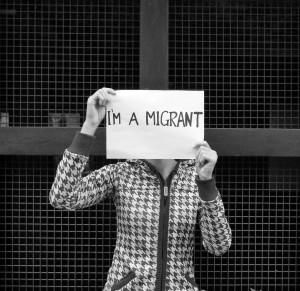 This time of year brings with it that familiar sense of getting back to the old routine. For some, it’s a time of packing the kids up with new PE kits and packed lunch boxes. For those in higher education institutions, it’s a time of welcoming new students who are [hopefully] fresh, aspirational and curious for new knowledge. It’s also a time of movement for many new students - across roads to new schools; across cities to higher education, or, for many international students, across continents and countries. Amongst possible reasons for migration, education - as a means of improving life chances - is up there at the top.
This time of year brings with it that familiar sense of getting back to the old routine. For some, it’s a time of packing the kids up with new PE kits and packed lunch boxes. For those in higher education institutions, it’s a time of welcoming new students who are [hopefully] fresh, aspirational and curious for new knowledge. It’s also a time of movement for many new students - across roads to new schools; across cities to higher education, or, for many international students, across continents and countries. Amongst possible reasons for migration, education - as a means of improving life chances - is up there at the top.
Yet within the press, stories regularly appear which associate migration negatively with education. They portray our schools as collapsing under the pressures of migrant populations. Higher education institutions are also presented as potential weak spots in the government’s attempts to manage migration, as the recent events at London Metropolitan University demonstrate.
All too often, migration is seen as an exception to the norm, an event that disrupts education. At its most extreme, this view renders those who live life permanently on the move (such as pastoralists) as living an anachronistic way of life that is intrinsically incompatible with educational provisions designed for sedentary populations (see Dyer 2012). Despite the usual hyperboly of these negative readings, there is some truth in the fact that educational systems are facing new challenges associated with migration. How best can teachers educate an increasingly more complex and diverse society? Are our educational systems fit for purpose?
Critical or swamped spaces?
These questions were central themes in last month’s British Association of International and Comparative Education’s conference on education, mobility and migration at Churchill College, Cambridge (for which I was on the organising panel). The conference was a chance to bring together educationalists and migration specialists to discuss the experiences of migrants within international school systems. Across the board, the value of education for migrant populations was repeatedly affirmed. Education is an important factor for integration; schools are critical spaces for migrant children and their families to make contact with members of receiving communities. They offer spaces for children to observe conventions and learn the rules of the dominant discourses and language (Adams and Kirova 2006), all important in facilitating social interaction, economic integration and participation in society.
However, presentations at the conference revealed that in the so-called ‘swamped’ systems of the Global North, uncomfortable tensions are emerging in schools between teachers’ desires to teach and evidence of schools as increasingly a site in which immigration controls pervade. Compulsory education is an area which in theory should be immune; full-time education for all children of compulsory school age is a right irrespective of the immigration status of the child.
Nevertheless, a number of presentations at the conference pointed to the encroaching of border controls into the education sphere. Nando Sigona and Vanessa Hughes (2012) discussed their research on irregular migrant children in the UK and spoke of how some teachers feel increasingly under pressure to perform ‘immigration control-like tasks’ in their dealings with irregular migrant children. We also heard from doctoral student Aoife Horgan about young separated asylum-seekers in the Irish care system who, once reaching 18, are subjected to ‘targeted dispersal’ and removed far away from their existing care-placements. This often coincides with their final year exams. Following their dispersal, these young people are unable to access further education, unable to work and have to live instead on a miserable €19.10 a week.
Whose responsibility is it?
The presentations also drew attention to the wider problems of public services regulating migrants through policing access to privileges and benefits, an issue facing not just education, but other public institutions. Last week’s BBC Panorama for example exposed the problem of ‘health tourists’ unlawfully accessing the National Health Service, in which the fault was laid at the door of hospital staff, who were presented as ‘lax’ for failing to check patient’s eligibility.
Likewise in the sphere of education, admissions tutors at further and higher education colleges are increasingly confronted with the burden of translating the obfuscating and complex raft of entitlement rules to prospective students. Having recently conducted a mapping exercise of the regulations about entitlement to education and other public services for family migrants in the IMPACIM project it is unsurprising to me that busy tutors (as much as doctor’s receptionists) unwittingly perhaps, but regularly nevertheless, misadvise migrants on their eligibility to services. Regardless of how this situation arises, the conference highlighted the devastating personal consequences for students who find their educational careers truncated.
What happens to the individual educational career?
When considering the broader consideration of the conference of whether educational systems are fit for purpose, I think therefore we must also reconsider what is their purpose? In common with other public institutions, education systems are under increasing pressure to regulate and monitor migrants. But, teaching for most is still seen as a vocation, driven by a desire to improve someone’s life chances, and in this sentiment, the aims of migrants and teachers coincide. As one senior manager in Nando and Vanessa’s study summed up, ‘I work in a school. I don’t work for UKBA. That’s not the job I applied for’ (Sigona and Hughes 2012). It is not only a question of ensuring the rules, boundaries and limits are more transparent for teachers, but also about respecting teachers’ professional code of conduct and their views about what they consider is and is not part of their job.
The conference ended with presentations from speakers from NGOs (including Lisa Doyle, Refugee Council and Catherine Gladwell, Refugee Support Network). These were sobering in underlining that no matter how much goodwill exists among teachers and educators in educating migrant young people, the reality is that many in Northern migration regimes will face an insurmountable cliff-face which redefines their legal entitlement to education once they reach the age of post-compulsory education.
 At this point, many young migrants are unlikely to be able to afford further or higher education: the classification of most migrants (including asylum-seekers with discretionary leave to remain) as international students renders them liable to pay fees of £13,000 a year, a combined cost of £39,000 in fee costs alone for a typical 3 year undergraduate degree. They are ineligible for student support in the form of loans and bursaries, but equally prohibited from working. In concluding, I’ll finish by spreading the word - perhaps it is time for universities (including my own) to consider fee waivers for high achievers finding their educational careers cut short by their legal status? (see Article 26, an NGO which campaigns for asylum-seeker HE fee waivers)
At this point, many young migrants are unlikely to be able to afford further or higher education: the classification of most migrants (including asylum-seekers with discretionary leave to remain) as international students renders them liable to pay fees of £13,000 a year, a combined cost of £39,000 in fee costs alone for a typical 3 year undergraduate degree. They are ineligible for student support in the form of loans and bursaries, but equally prohibited from working. In concluding, I’ll finish by spreading the word - perhaps it is time for universities (including my own) to consider fee waivers for high achievers finding their educational careers cut short by their legal status? (see Article 26, an NGO which campaigns for asylum-seeker HE fee waivers)
References
Dyer, C. (2012) Formal education and pastoralism in western India: inclusion, or adverse incorporation? Compare 42, 2 pp. 259-282
Adams, L.D. and Kirova, A. 2006. Global Migration and Education: Schools, Children, and Families. London: Routledge.
Sigona, N. and Hughes, V.2012. "No Way Out, No Way In. Irregular migrant children and families in the UK". COMPAS Research Report, University of Oxford, 2012.
